Dear Friends,
For Ambiguous Zones 11, we are pleased to introduce guest author Keenan Jay, who wrote an insightful essay on Arakawa’s solo exhibition of mainly coffin works at the Zuni Gallery in Buffalo, NY, in March of 1964. Jay is a researcher of modern and contemporary art with an interest in diasporic art and the neo-avant-garde. He was a 2021 research fellow with PoNJA-GenKon and Asia Art Archive in America and has recently presented at the annual conference of the Association for Asian American Studies among others. He has been conducting a series of oral history interviews on Montez Press Radio since 2019.
Yours in the reversible destiny mode,
Reversible Destiny Foundation and ARAKAWA+GINS Tokyo Office
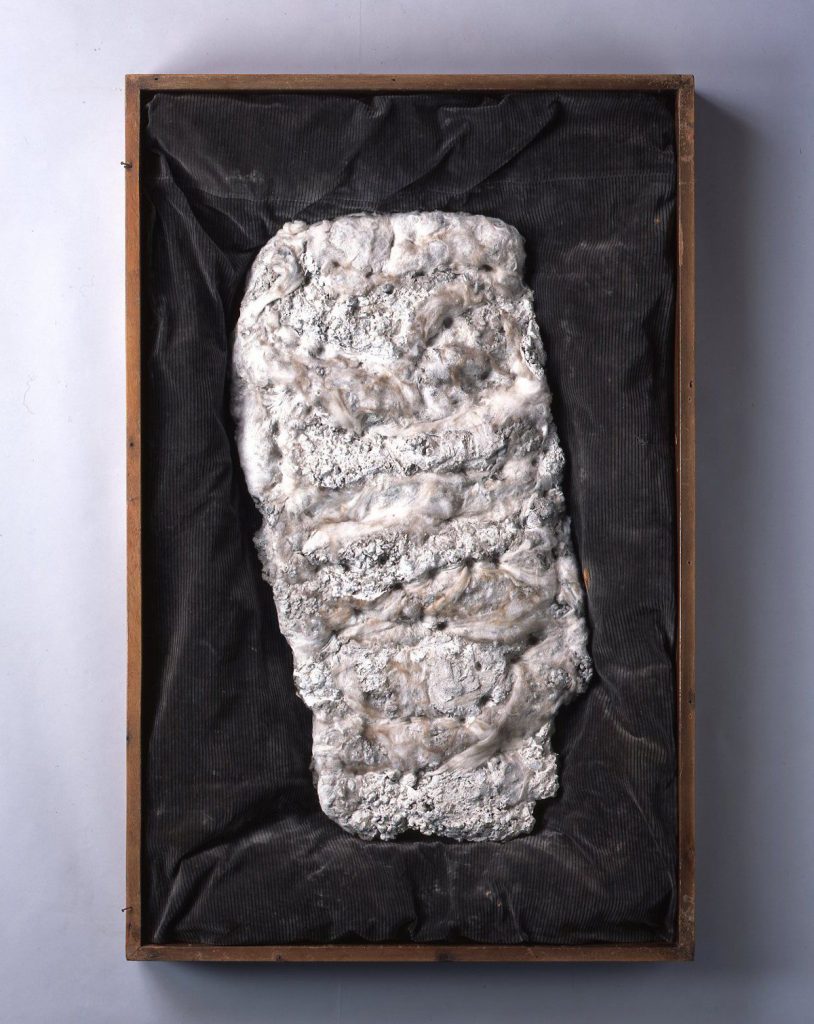
In a January 1967 Artforum article, critic Yoshiaki Tono recalls his surprise at a new group of artists who had appeared in Tokyo during the late 1950s. He frames these artists, who called their collective Neo Dada (initially the Neo Dadaism Organizers), through their formative postwar upbringing, writing that “they desired an art which could respond more directly . . . to the chaotic realities of the world they knew.”[1] This world was that of Japan during reconstruction, a world trying to come to terms with its wartime imperialism against a backdrop of leveled cities and widespread famine. More recently, it was the world of the ensuing development and consumerism that had turned “the teeming city of Tokyo” into an “immense junk-yard”[2] and of the Anpo treaty’s re-signing, which would establish Japan’s Cold War role despite popular protests against it. Given that the works of Neo Dada were inextricable from these circumstances, Tono argued that the group’s activities should be understood primarily in sociological terms.
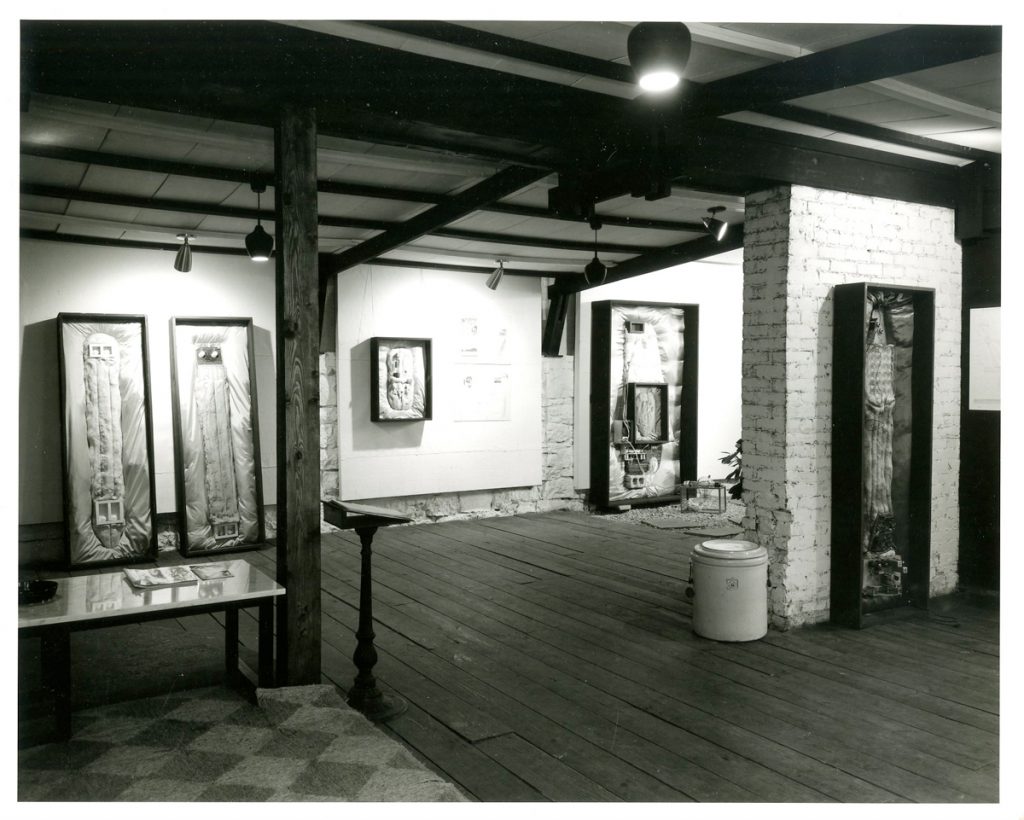
With regard to one of the group’s members, Shusaku Arakawa, Tono goes on to observe in the artist’s work an “obsession with death and nothingness,” reflecting the sensibilities of the “post-Hiroshima generation.”[3] Tono felt this was particularly true of Arakawa’s coffin-like sculptures, perhaps Arakawa’s best-known works outside of his diagrammatic paintings and architectural projects with Madeline Gins. These ominous boxes confronted the viewer with proportions suggestive of the human figures, requiring the viewer to remove the lids to reveal the biomorphic and mutant masses contained inside (fig. 1). Made primarily of cement and cotton, Arakawa also sometimes embedded objects from Tokyo’s industrial refuse into these compositions. However, he typically used such discarded objects sparingly, turning their original use-values alien through their isolated appropriation.
Tono then moves on to a discussion of Arakawa’s immigration to New York in 1961 and, jumping to 1963, his abandonment of the coffin works in favor of the diagrammatic paintings with which he would establish his reputation internationally. 1963 saw Arakawa’s first Galerie Schmela exhibition in Düsseldorf and the beginning of his collaboration with Madeline Gins on The Mechanism of Meaning, with his work at this time employing diagrammatic and informational visual languages that departed from his sculptural practice. By Tono’s condensed account, it would therefore indeed seem that “Arakawa left his boxes in Japan” as has since been commonly assumed.[4]
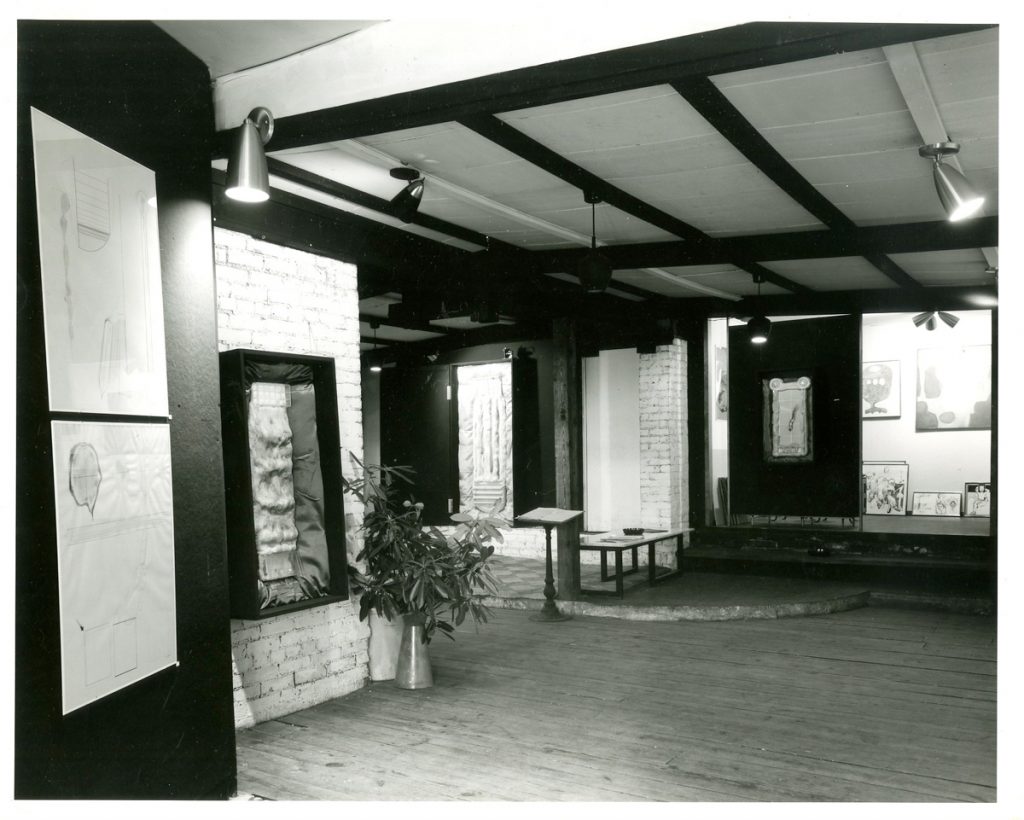
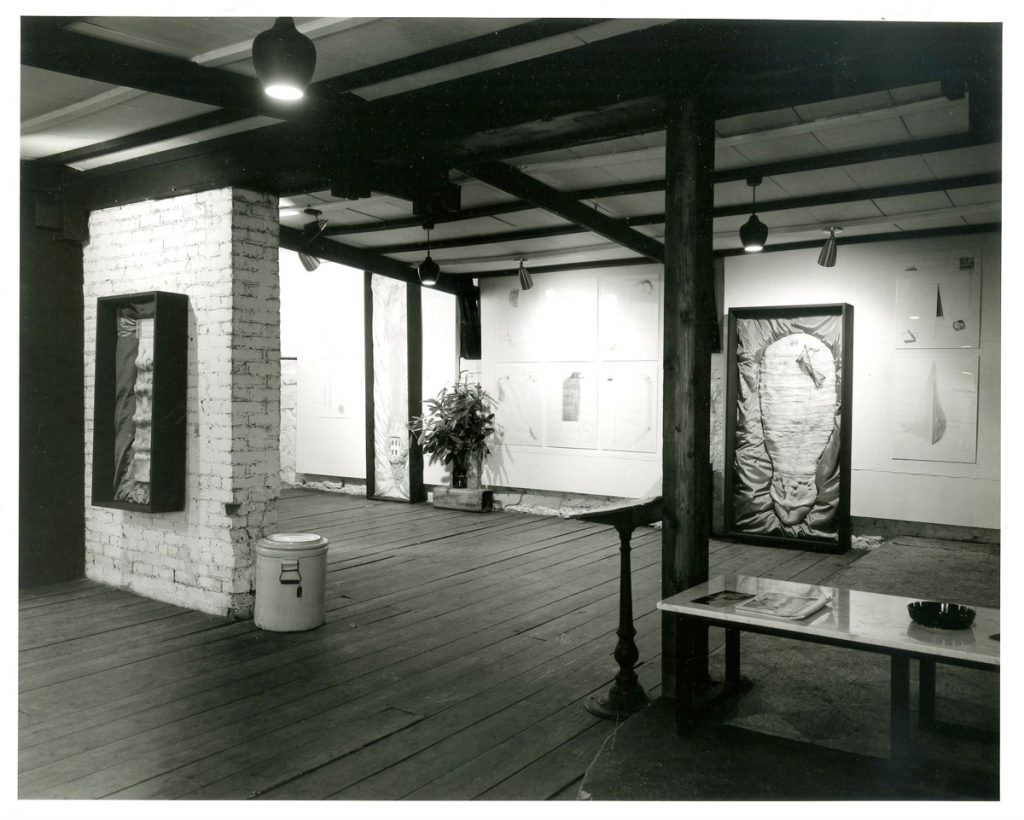
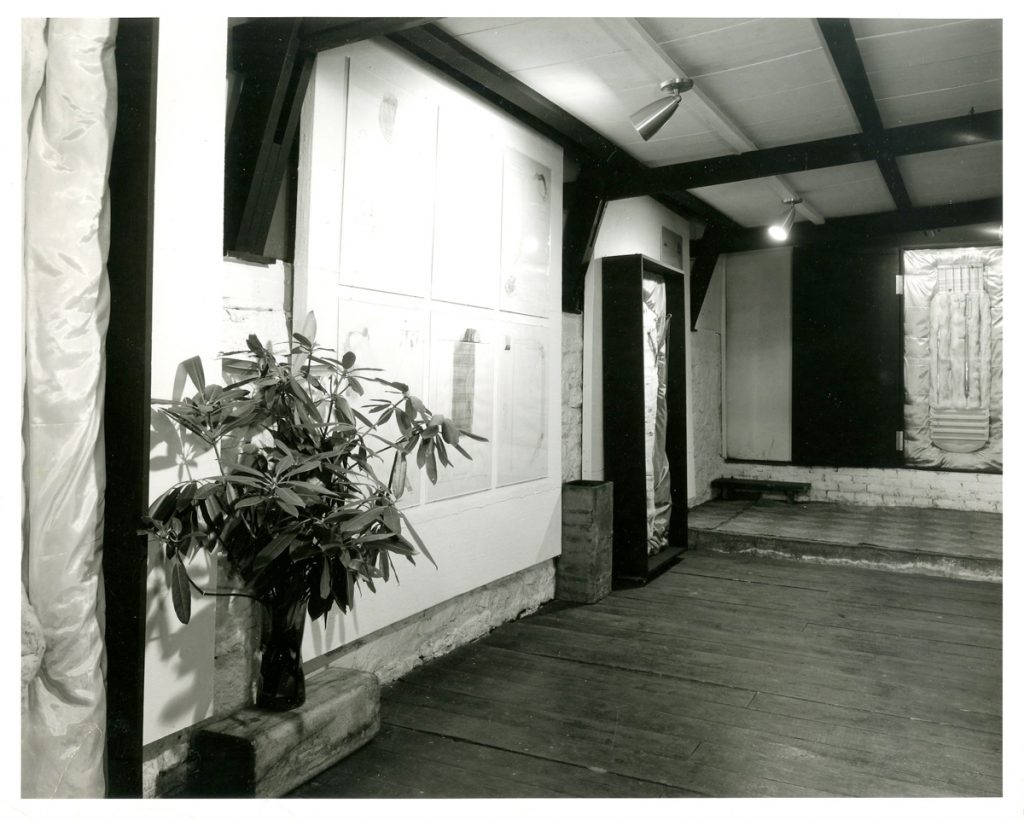
In the years immediately following Arakawa’s move to New York, however, he not only continued to produce new coffin works but also substantially developed their materials and forms. An exhibition at Zuni Gallery in Buffalo, NY, showcases the culmination of this brief but compelling period (figs. 2-5).
An unpretentious gallery in a basement in Buffalo, New York, artists Ben Perrone and Adele Cohen started Zuni in 1963 and operated it for two years with Arakawa’s solo presentation occurring in March of 1964. At first glance, the works in the show are familiar: the coffin-like sculptures that gained Arakawa notoriety in Tokyo populate the space and are interspersed with diagrammatic drawings that evoke his painterly output in New York. Yet we soon notice a difference in these coffin works, with their unusual mechanical parts conjuring an image of reanimation rather than the mortuary stillness of their predecessors. The Zuni exhibition therefore reveals a distinct period within Arakawa’s already established body of coffin works that has gone relatively unstudied, marked by an increased complexity and modification via mechanical apparatuses.
The Zuni show had been coordinated by Bill Dorr, whom Perrone described to the Reversible Destiny Foundation as “somewhat of an entrepreneur in the arts.”[5] Dorr also helped organize a group exhibition a few months prior to Arakawa’s solo show, featuring Arakawa, Ay-O, Masunobu Yoshimura (another central Neo Dada artist), Robert Morris, Dorr himself, and other artists including John Chamberlain, Robert Motherwell, Claes Oldenberg, and Jim Dine (fig. 6).[6] While no known documentation from the Zuni group show remains, the first four of these artists had shown together in a separate group exhibition almost a year earlier entitled Boxing Match at Gordon’s Fifth Avenue Gallery in New York City.
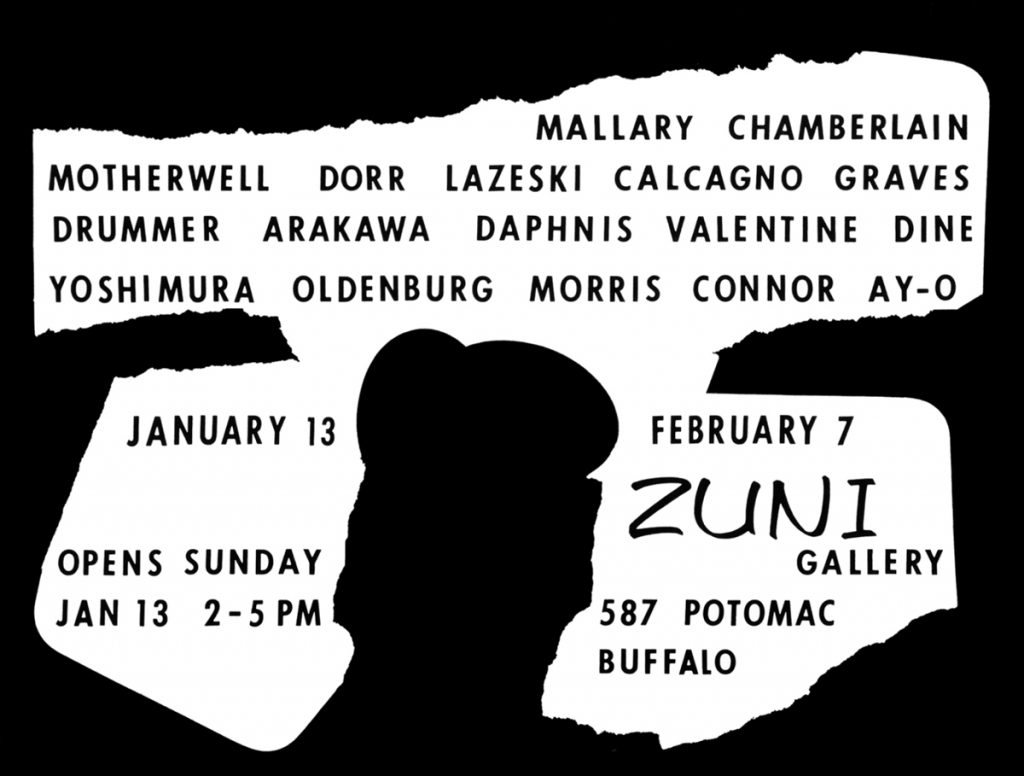
Viewing Arakawa’s works in the Boxing Match show in relation to the works presented in the solo exhibition reveals the increasing orientation toward mechanization as more than a passing whim by the artist.[7] For example, we know from a letter sent by Dorr to Arakawa that Dorr intended to exhibit at least some of the works from the Boxing Match show at Arakawa’s Zuni solo show. In the letter, Dorr specifically mentions Mechanized Plant (1963), which was ultimately not included. Be Kind Enough to Turn the Switch On (1962), with its distinctive mechanical device perched atop the coffin-like box’s right-hand corner, does appear to have been exhibited in both shows according to available documentation. It is impossible, however, to verify whether the contents of the coffins were the same in both exhibitions as the documentation from Boxing Match only shows it with its lid closed.
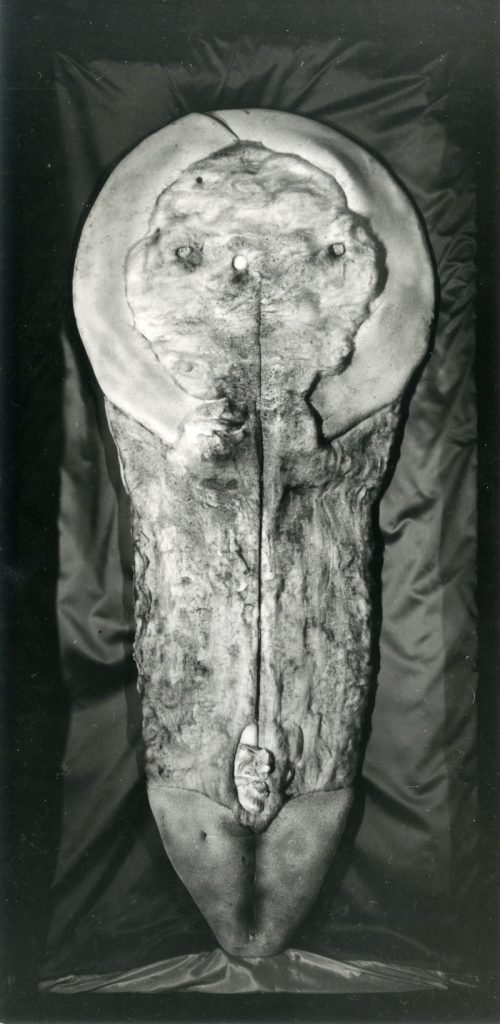
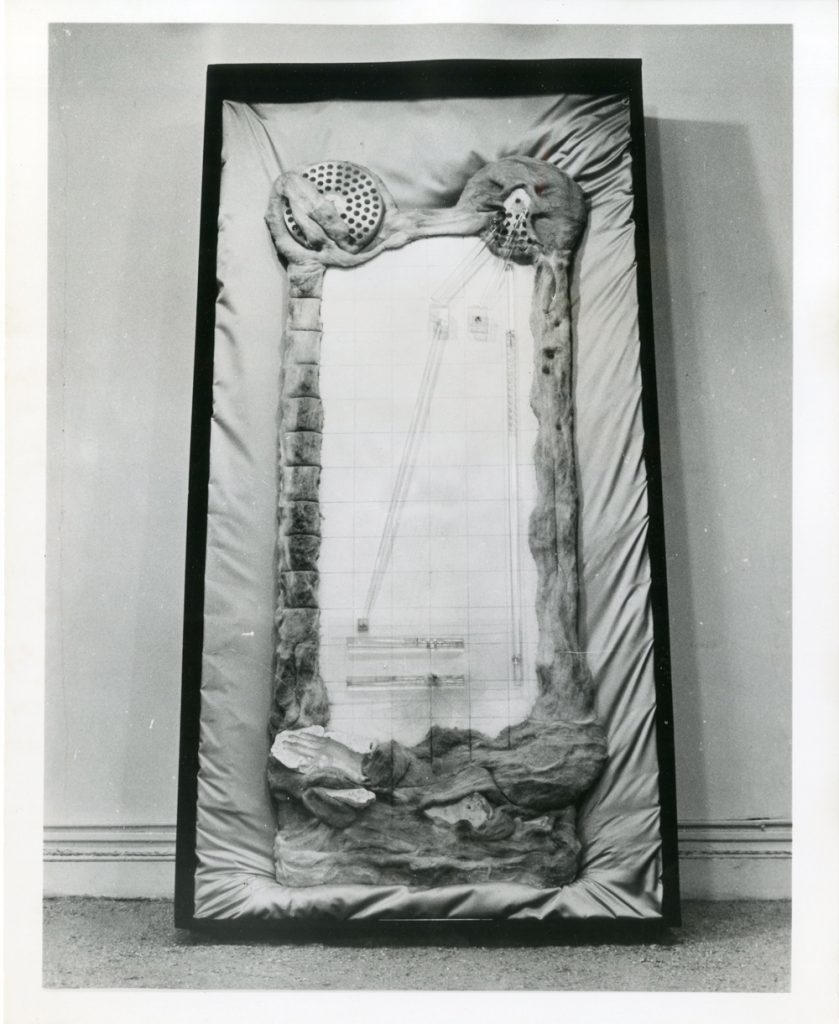
In a review of Boxing Match, Donald Judd writes about two other works that reiterate this differentiating development in Arakawa’s first few years in New York. Judd describes the earlier of the two works, The Law of Perspective Discovered for the Second Time (1960) as “[a] four-by-eight black box, with a lid, [that] contains, laid out on pink silk, a bifurcated ray with a wide crest and a phallic tail of foam rubber, a body of cotton and three eyes which are lenses.” (fig. 7) [8] In the photographic documentation, this work appears with its lid closed behind Yoshimura’s sculptures. This coffin is dated to 1960 in the Dwan Gallery archive, although an October 1963 issue of Bijutsu Techo seems to suggest that its production occurred after Arakawa’s move in late 1961.[9] Regardless, it seems this work was produced prior to the other coffin work that Judd describes, which appears to be The Method of Advancing a Great Distance by Descending (1962) (fig. 8) with its “parts of a chemical apparatus, a reversed plaster hand, a plastic case and a minute blinking light.”[10] This work can be seen peeking out from behind Robert Morris’s Untitled (Cloud) (1962) in the background of one of the exhibition’s installation shots.[11] While the materials used in The Law of Perspective Discovered for the Second Time are congruent with the materials and forms Arakawa used in the coffin works in Tokyo, The Method of Advancing a Great Distance by Descending displays an increased use of mechanical and manufactured parts to new effect.
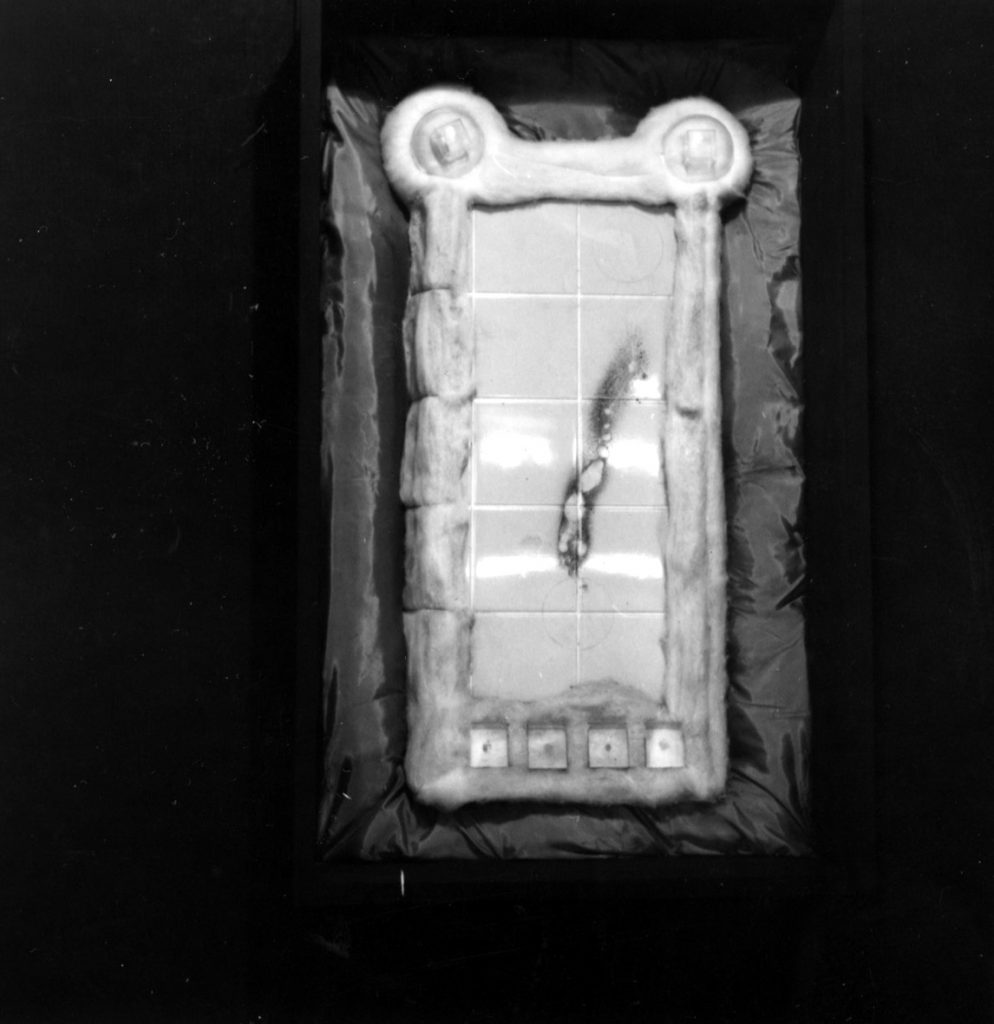
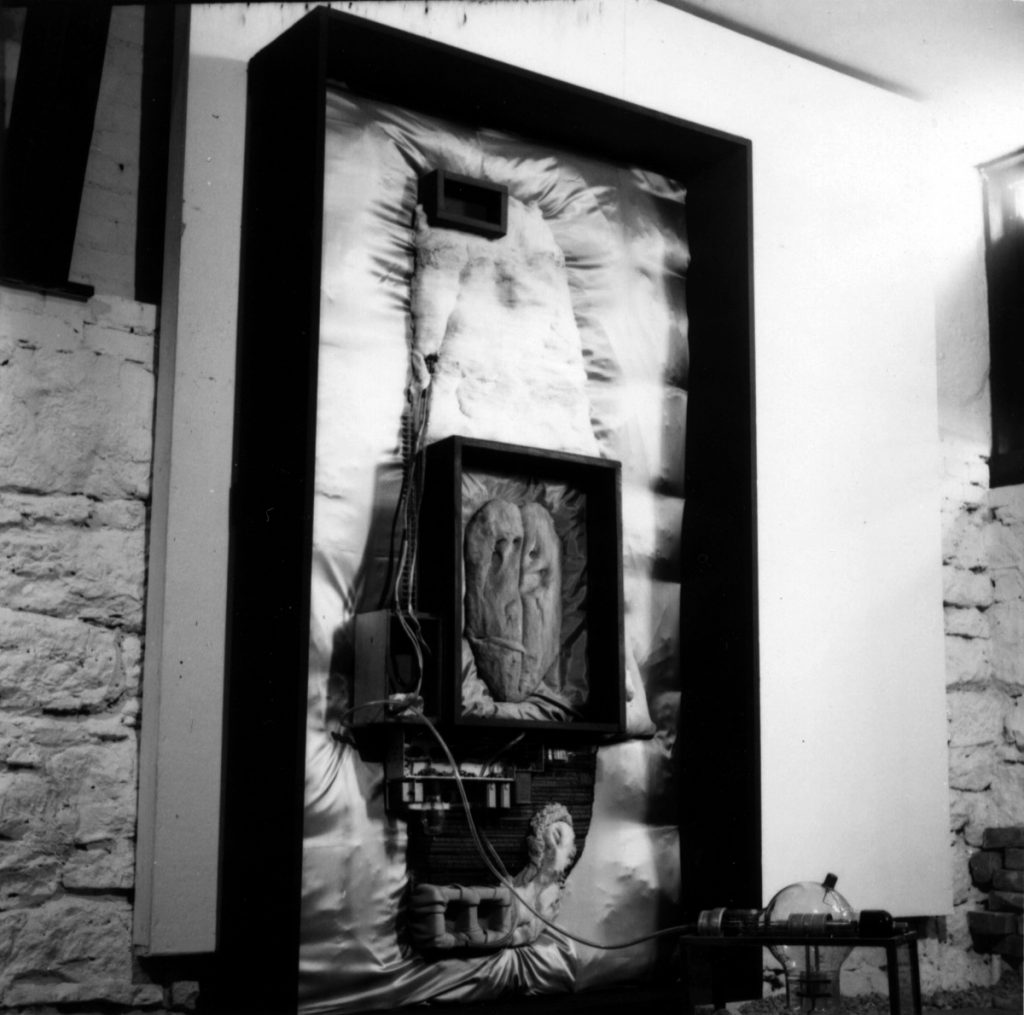
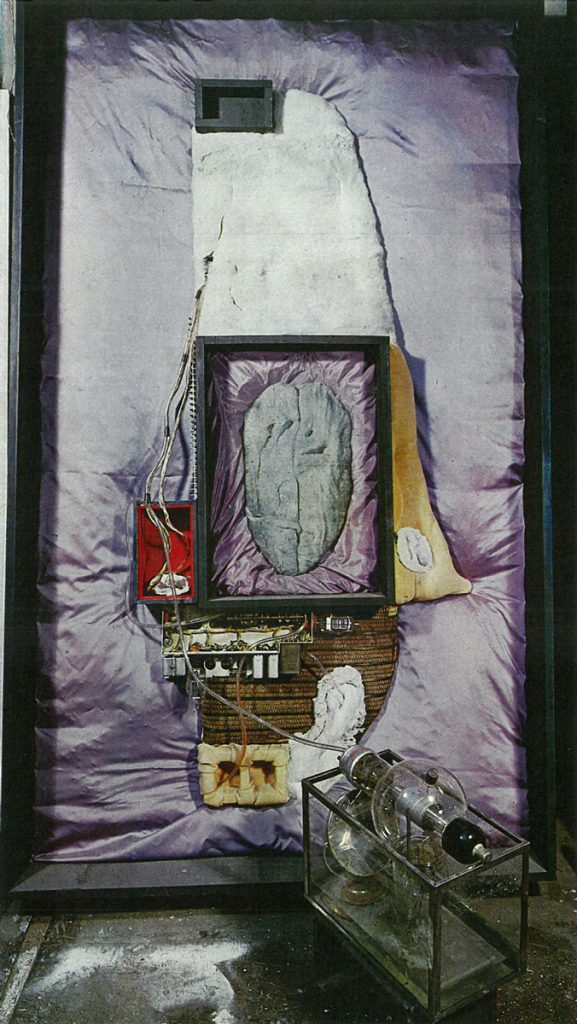
The Zuni solo exhibition of 1964, nearly one year after the Boxing Match show, further supports such a trend through a new set of coffin works.[12] These works contain long tubular glass rods arranged in organized rows, compartmentalized plexiglass structures, and an abundance of wires, switches, buttons, and hinges (fig. 9). In general, the Zuni works are distinct in their language of technological complexity uncharacteristic of the coffin sculptures before Boxing Match. One such piece, referred to simply as Work (1963), makes apparent the extent to which the industrial parts Arakawa utilized no longer adorn the corporeal masses and instead have become incorporated in ways that imply elaborate functions (fig. 10a).[13] This large coffin sculpture holds a smaller one within its complex apparatus, as if expropriating a vital resource from it. Appearing in color in a January 1964 issue of Mizue magazine, the nesting coffins entombing their respective grotesque objects on beds of lilac satin produce a humorous mise en abyme effect. (fig. 10b). In this remarkable instance of self-referentiality, the smaller coffin—reminiscent of the earlier and more rudimentary coffin works—is hooked up to a series of conduits and wires housed in different interconnected compartments. One cord spills from the frame of the larger coffin, connecting it to a bulbous glass fixture suspended above a small vitrine on the floor, with the sinister apparatus expanding beyond its rectilinear container in a hitherto unseen manner.
Arakawa’s drawings in the Zuni solo show also seem to be caught in a state of transition, though this time moving backwards from the visual languages of instrumental reason seen in the diagram paintings toward the biomorphism in his preceding works. While these drawings employ the schematic style familiar from his mid-career paintings, they also feature more organic, growth-like forms and compositions recalling early drawings like Le temps perdu (1958-1959) that reflect Arakawa’s interest in medical science and ontogeny. Arakawa’s choice of watercolor in the Zuni drawings, whose transparent wash preserves the presence of hand by indexing the duration and weight of its application, heightens this effect as the brushwork does not yet display the removal or contrivance of his touch seen in the later paintings. Accordingly, these drawings may be seen to link the corporeality of the coffin works and the diagrammatic space of the paintings through a visceral sense of embodiment.
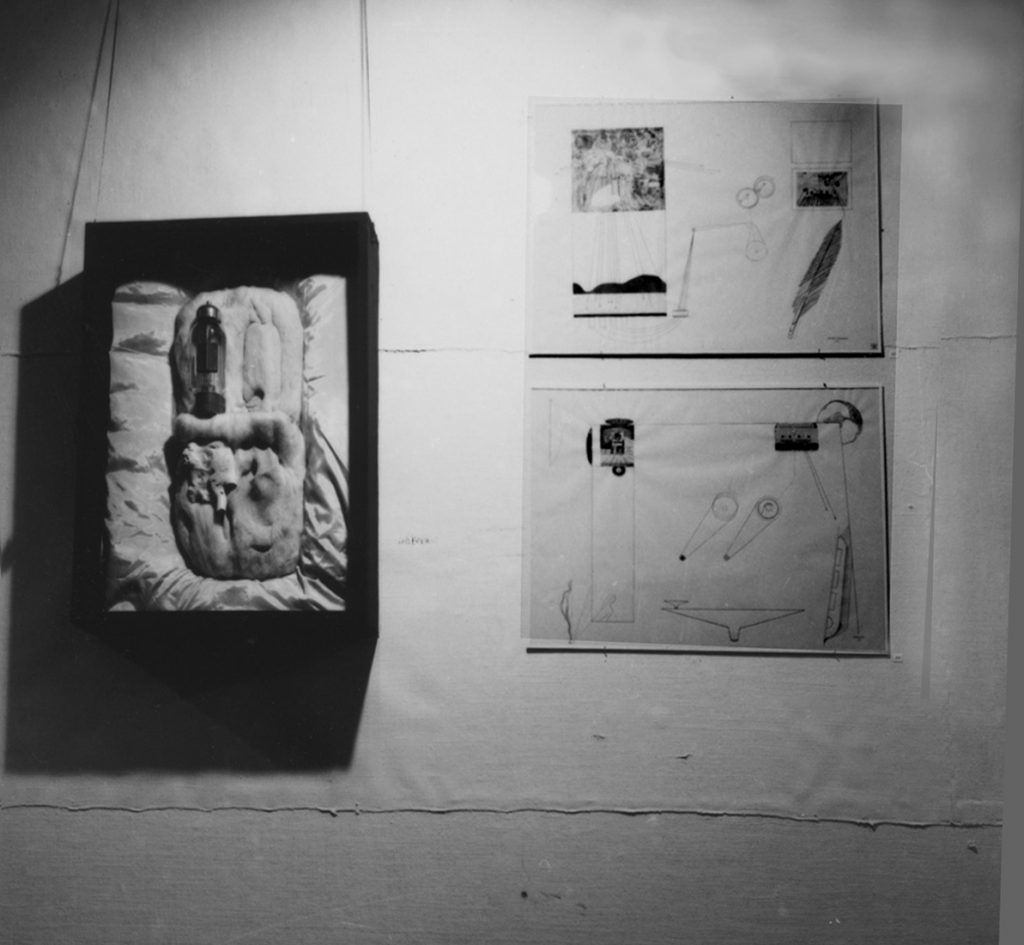
Arakawa’s relationship with Duchamp, which began upon the former’s arrival in New York in 1961, provides a productive place to start. According to an oral history interview conducted by Reiko Tomii and Midori Yoshimoto, Arakawa called Duchamp from the airport immediately after landing and the two met in Washington Square Park that day.[14] They remained friends until Duchamp’s death in 1968 and his influence would have profound consequences for Arakawa’s practice.
Abundant references to the older artist in his later coffin works such as the positive and negative casts of body parts, which recall Duchamp’s own casts in With my tongue in my cheek (1959), and his “erotic objects” indicate this. We also observe allusions in Arakawa’s titling, such as the previously-mentioned The Method of Advancing a Great Distance by Descending, which pays homage to Duchamp’s Nude Descending a Staircase No. 2, (1912). Although this work was not shown at Zuni, likely due to its inclusion by John Weber in the Dwan Gallery’s own box-themed show that took place from February 2nd-29th just prior to the Zuni show, another smaller, unidentified work that was shown at Zuni shares many of its distinctive features. These include its mouse-eared silhouette and the body’s framing of a gridded, topological plane akin to the Euclidean space of the diagrammatic drawings (fig. 12). Such recurring features suggest that this smaller work might have served as a study or model for The Method of Advancing a Great Distance by Descending.
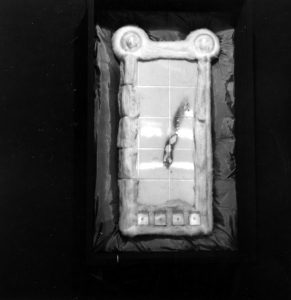
These associations help to contextualize the series of square doors set into the base of the smaller Zuni work, a feature also found in Arakawa’s Diagram with Duchamp’s Glass as a Minor Detail (1964). These doors mirror the three square “draft pistons” in the gaseous form emitted by the Bride in the upper domain of the The Bride Stripped Bare by Her Bachelors, Even (1915-1923), also known as The Large Glass. Here, a dialogue between The Large Glass’s bachelor machines and Arakawa’s more cyborgic coffin works becomes apparent: both reimagined the figure through technologies of absurd expenditure. Like the bachelor machines’ fruitless endeavoring, the mechanization of Arakawa’s inert masses suggests a state between living and dead, a laboring restricted to the maintenance of a diminished existence. Formal details such as these in the Zuni exhibition underscore the importance of Duchamp to Arakawa’s new integration of technological advancement into his coffins during this period and leave many questions to be explored.
Diagram with Duchamp’s Glass as a Minor Detail was shown in Arakawa’s following exhibition, Die-agrams, which definitively marked his divergence away from the coffin sculpture format while maintaining a connection to his fascination with death in the next major period of his oeuvre. A further nod to Duchamp with its use of pun, this inaugural solo exhibition at the Dwan Gallery, Los Angeles, opened on March 29th of 1964, less than a week after the Zuni exhibition closed. It seems that it would then be more accurate to say that Arakawa left his boxes in Buffalo than in Japan as suggested in Tono’s article cited at the beginning of this essay. This misunderstanding was further perpetuated by Arakawa’s omission of the Zuni solo show from his exhibition record altogether by the time of his show at the Stedelijk van Abbemuseum in December 1966. His reasons for this were never stated, though it suggests that he no longer saw the exhibition and its works as representative of his artistic identity and preferred them off of the art historical record. That this body of work coincides with his moving to New York, befriending a cult hero of the avant-garde in Duchamp, and his first solo shows with successful commercial galleries in America and Europe does not seem to be without significance. Further study of the late coffins works as an intermediary period between leaving Tokyo and his establishment in New York would therefore not only yield new insight into these relatively obscure works, but also tell us much about Arakawa’s perception of the artistic field at this crucial, diasporic juncture in his career.
[1] Yoshiaki Tono, “Shusaku Arakawa, Tomio Miki, and Tetsumi Kudo,” Artforum (January 1967): 53.
[2] Tono, “Shusaku Arakawa,” 53.
[3] Tono, “Shusaku Arakawa,” 53.
[4] Tono, “Shusaku Arakawa,” 55.
[5] Email correspondence between Ben Perrone and Amara Magloughlin, June 9th, 2018.
[6] These latter artists appear to have come from Dorr’s own collection. Email correspondence between Ben Perrone and Amara Magloughlin, June 9th, 2018.
[7] This exhibition was revisited by Castelli Gallery in 2019. The exhibition catalog includes materials crucial to this research and may be accessed at https://www.castelligallery.com/publications/1963-boxing-match-revisited.
[8] Donald Judd, “Reviews for Arts Magazine, April – May/June 1963,” in Donald Judd: Complete Writings 1959-1975: Gallery Reviews, Book Reviews, Articles, Letters to the Editor, Reports, Statements, Complaints (Halifax: Press of the Nova Scotia College of Art and Design, 1975), 90.
[9] Yusuke Nakahara, “Shusaku Arakawa,” Bijutsu Techo (October 1963): n.p.
[10] Judd, “Reviews,” 90.
[11] ARTnews reviewer K.L. writes that “Cloud, a horizontal box (a grey plane) suspended at eye level, gives a curious effect of blindness.” K.L., “Boxing Match,” ARTnews (March 1963): n.p. Re-printed in Boxing Match: 4 Sculptors: Arakawa, Ay-O, Morris, Yoshimura, ed. Castelli Gallery (New York, NY: Castelli Gallery, 2019): 24.
[12] The possible exception of Be Kind Enough to Turn the Switch On is mentioned above.
[13] Yoshiaki Tono, “Statement by Japanese Vanguard Artists from Saito to Arakawa,” Mizue (January 1964): 26.
[14] Oral History Interview with Shusaku Arakawa, conducted by Midori Yoshimoto and Reiko Tomii, April 4, 2009, Oral History Archives of Japanese Art (URL: https://oralarthistory.org/
